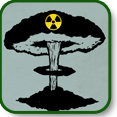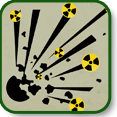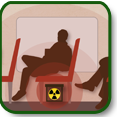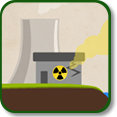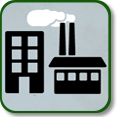Types of Radiation Emergencies
Radiation emergencies may be intentional (e.g., caused by terrorists) or unintentional. Below are some examples of different types of radiation emergencies. Click on the icons to find out what to do if a radiation emergency happens in your area.
Nuclear Emergencies
- A nuclear emergency involves the explosion of a nuclear weapon or improvised nuclear device (IND).
- The explosion produces an intense pulse of heat, light, air pressure, and radiation.
- Nuclear explosions produce fallout (radioactive materials that can be carried long distances by the wind).
Dirty Bomb or Radiological Dispersal Device (RDD)
- A dirty bomb (also known as a radiological dispersal device) is a mix of explosives such as dynamite, with radioactive powder or pellets.
- A dirty bomb cannot create an atomic blast.
- When the explosives are set off, the blast carries radioactive material into the surrounding area.
Radiological Exposure Device (RED)
- A radiological exposure device (also called a hidden sealed source) is made of or contains radioactive material.
- REDs are hidden from sight to expose people to radiation without their knowledge.
Nuclear Power Plant Accident
- An accident at a nuclear power plant could release radiation over an area.
- Nuclear power plants have many safety and security procedures in place and are closely monitored by the Nuclear Regulatory Commission (NRC)
Transportation Accidents
- It is very unlikely that a transportation accident involving radiation would result in any radiation-related injuries or illnesses.
- Shipments involving significant amounts of radioactive material are required to have documentation, labels, and placards identifying their cargo as radioactive.
Occupational Accidents
- Radiation sources are found in a wide range of settings such as health care facilities, research institutions, and manufacturing operations.
- Accidents can occur if the radiation source is used improperly, or if safety controls fail.
Learn more about occupational accidents
- Page last reviewed: September 17, 2013
- Page last updated: October 13, 2014
- Content source:
- Maintained By:





 ShareCompartir
ShareCompartir
